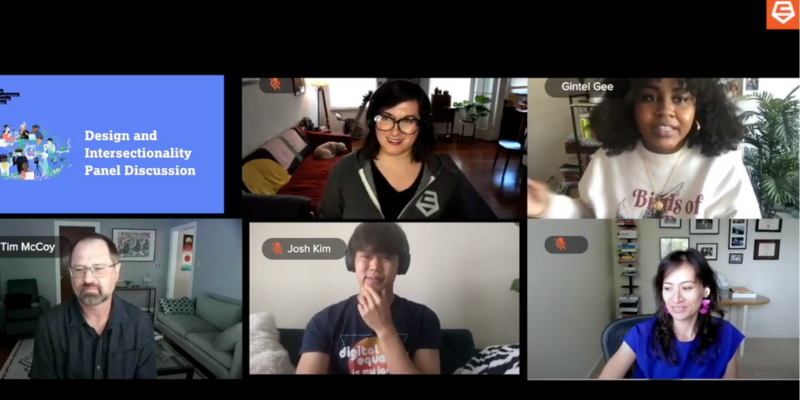
Experts Offer Insights on How to Build Accessible Products During Carbon Five Panel Discussion on Intersectionality
Four product development experts gathered in June to discuss how teams can create accessible products that are inclusive for users whose backgrounds may be very different from their own. The panel discussion, titled “Design and Intersectionality,” was part of San Francisco Design Week and was sponsored by Carbon Five. Panelists included designers and a product manager who work directly with marginalized groups that are often overlooked in tech.
The idea to host a panel on intersectionality stemmed from conversations that began at Carbon Five in the aftermath of the protests that followed the killing of George Floyd in May 2020, explained moderator and Carbon Five Principal Designer Nicole Thayer. Through these conversations, Carbon Five team members realized that the agile process can often exclude marginalized groups, and they began to think about how they could better combat systemic racism and bias in the tech industry.
Due in part to the nature of Carbon Five’s work as a digital product development consultancy, a large portion of the discussion centered around how to work with stakeholders who may not always consider accessibility and inclusion when building products.
Jennifer Skene, a senior product manager at Segment, suggested that teams bring up the topic of accessibility with stakeholders early on and include goals around it when setting Key Performance Indicators (KPIs). By bringing accessibility up early, there’s a higher chance that it will be prioritized throughout the product life cycle, she said.
“If you don’t do this upfront, and you realize during your iterative process, ‘Oh, we didn’t think about this, we need to change this and that,’ the most helpful thing for me is to pull in everybody on the team and have conversations around it,” Skene said. “And to think about, ‘Can we still meet our deadline if we add this?’ Being open and creative with your team about how you could fix those kinds of issues is key.”
Starting a conversation with stakeholders about intersectionality is often easier said than done, said Josh Kim, a senior designer and accessibility specialist at AdHoc. But open communication, transparency, collaboration, and active listening are the keys to making that conversation a success, he said.
“Ironically, it’s about being a dolphin, not a shark,” said Kim. “And that means meeting people who may not know better where they are and creating safe spaces for them to ask ignorant kinds of questions. And guiding them towards the right resources and helping them understand why it’s important to design for marginalized groups, without making them seem like the big bad wolf.”
Everyone on the team should acknowledge and recognize the importance of building inclusive and accessible products, said Tim McCoy, senior director of product design at Zendesk. Holding leadership accountable is also crucial, he added.
“Make your executive stakeholders be in the [uncomfortable] position of having to say, ‘I don’t care about low sight users,” or “Meeting accessibility goals isn’t important to me,’ McCoy suggested. “These are becoming less tenable positions to hold. It can be as easy as saying [to them], ‘We think about these things, and you need to think about them too.’”
When it comes to bringing in a broader range of perspectives into design work, Carbon Five Senior Designer Gintel Gee suggested talking to people who are very unfamiliar with the product during usability testing sessions.
“Sometimes projects have a very vanilla sense of their users, where they’re thinking [the users] are all one certain type of person,” said Gee. “Especially being a Black woman, I always want to make sure that we’re looking at diversity, we’re looking at different types of people, and that we’re including those people — even if we have to do it through a usability test that’s a little bit outside of the framework that provided for the project … When it comes to edge cases, I think that we all have either been one or will become one.”